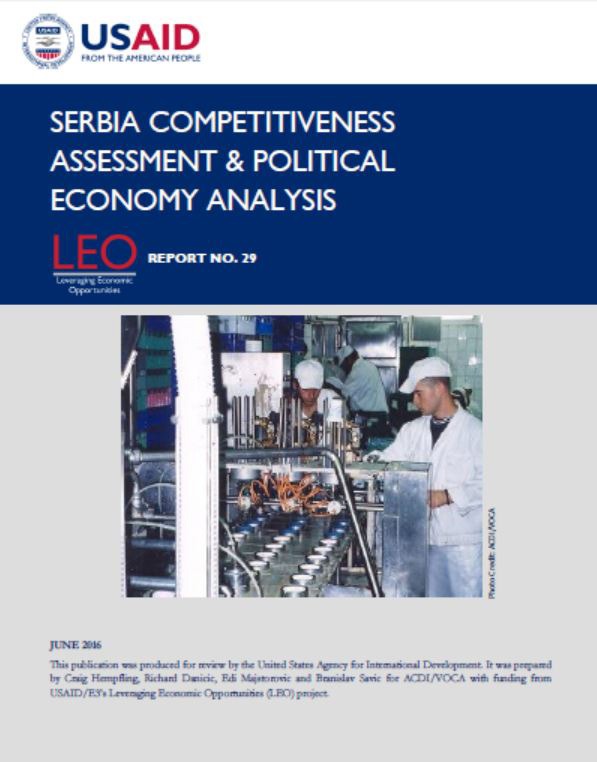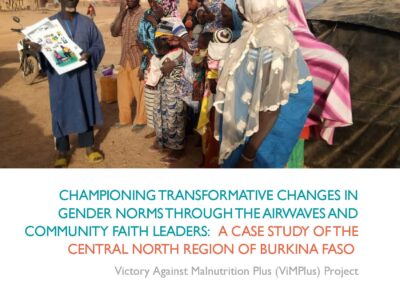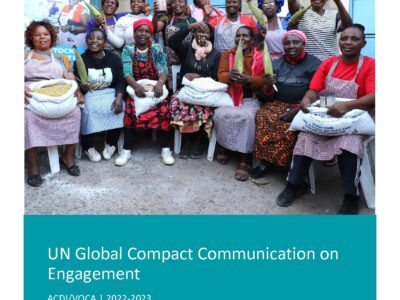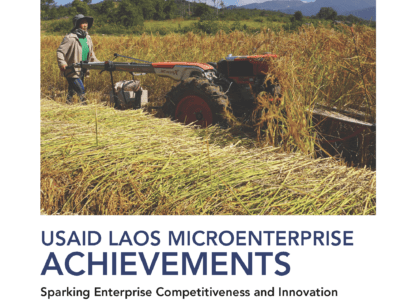
OBJECTIVE
This assessment seeks to identify the key factors constraining Serbia’s private MSME sector, and its ability to grow and compete, particularly in EU markets and against the companies and products of EU member states. This assessment utilized the Applied Political Economy Analysis (PEA) methodology to identify the constraints and establish the causal factors for those constraints. In line with the PEA findings, this assessment makes numerous programming recommendations for USAID to pursue to stimulate MSME growth and competitiveness. The full PEA results are presented in detail in the format of the framework in Annex 1.
ENTERPRISE VS. INSTITUTIONAL DEVELOPMENT
At the outset of the assessment, we collectively considered two broad categories of intervention: i) direct assistance to the MSME sector; or ii) institutional development and capacity building targeting institutions with mandates to support the MSME sector. As can be seen from the PEA results, the volume and obstinacy of constraints limited our optimism in effecting institutional change. Not completely ruling out institutional strengthening however, we have sought to identify strategies that can serve as a vehicle to strengthen those institutions directly linked to targeted actors or initiatives.
ASSESSMENT OVERVIEW
The assessment team, at times accompanied by USAID staff members, interviewed 149 MSMEs and support actors, examining the institutional framework and actors. Interviewed MSME-support actors included donors and their implementing partners, national and local public institutions, Chambers of Commerce, RDAs, associations and clusters and others throughout the country. At critical points during the assessment the team organized meetings and presentations with USAID staff to discuss the preliminary findings and further refine areas of interest. A detailed overview is presented in the Methodology section of this report.
POLITICAL ECONOMY ANALYSIS (PEA)
Serbia’s economic competitiveness remains essentially stagnant, placing 94th out of 144 economies; in the area of innovation, Serbia ranks 132nd of 140. The PEA framework was used to identify the main contributing factors for the current state of MSME competitiveness and innovation; the PEA framework identifies constraints and causality in four areas: i) Foundational Factors; ii) Rules of the Game; iii) Here & Now; and iv) Dynamics. In total, 31 constraints were identified in the four areas, together with detailed causal factors; of these 31 constraints, 14 were identified as “amenable to change.” The identified constraints that are amenable to change can be categorized in the following areas: ineffective institutional and policy support structure; lack of access to finance; flourishing gray market; underdeveloped supply chains; education system not responsive to labor market demands; lack of access to information; weak networks, linkages and cooperation of both MSMEs and institutions; lack of modern management skills and tools; and marginal donor effectiveness. For each of these constraints the team has prepared a list of potential programming recommendations, presented in the Actionable Recommendations section of this report.
RELEVANT DONOR INITIATIVES
Most donors and their implementing partners have struggled with impact and sustainability of private-sector development in Serbia. Breakthroughs may be on the horizon, however, as there may be something of an attitude shift among development practitioners to improve programming based on empirical data, objective monitoring and evaluation, and more effective attribution of impact, which should in turn better inform future programming. High-level synergies and collaboration between donors can contribute significantly to collective impact, and numerous programming and implementation recommendations are offered, some of which have been borrowed from other donor strategies. The most significant donor activities currently serving the MSME sector are supported by the EU, German GIZ, Swiss SDC and SECO, and the World Bank; their strategies and programs are overviewed in this report.
ENERGY & CONSTRUCTION SECTOR
At the request of USAID, the team has elaborated potential interventions in the Energy & Construction sector, specifically seeking opportunities in energy efficiency and renewable energy. Globally, this is an exciting and growing field ripe for impact in Serbia. Recent technological advancements have provided a wealth of new products, technologies and efficiency gains in renewables, lighting and control systems and other areas; and Serbia has been largely excluded from this transition. Serbia consistently ranks near the bottom of European countries in virtually all energy consumption indicators; its per capita energy consumption is four times that of Germany and its building heating requirements 2.5 times the EU average, fueled in part by energy subsidy policies, poor and outdated construction with respect to building “envelopes,” and the lack of metering systems in district heating systems. In all these areas, Serbia lags EU standards by considerable margins. German GIZ, Swiss SDC and SECO, and the German bank KfW are active and progressive in the energy sector, committing significant resources to improving efficiency and adapting new technologies, providing a wealth of synergistic opportunities for impact.
ORGANIZATIONAL NETWORK ANALYSIS (ONA)
The team has also applied ONA as an assessment tool to begin to determine and map the network of MSME supporting actors. During the interviews the team collected attributes for each actor including: organizational background data; staff and leadership gender; geographic coverage; clients and beneficiaries served; targeted economic sectors; and principle support activities. To map the networks and measure metrics, the team surveyed actors and relied on partnership data via their websites to determine their most key linkages, which will allow detailed network analysis and calculation of network metrics to measure network strength, cohesiveness and other indicators. The ONA analysis will be submitted as a separate document.







